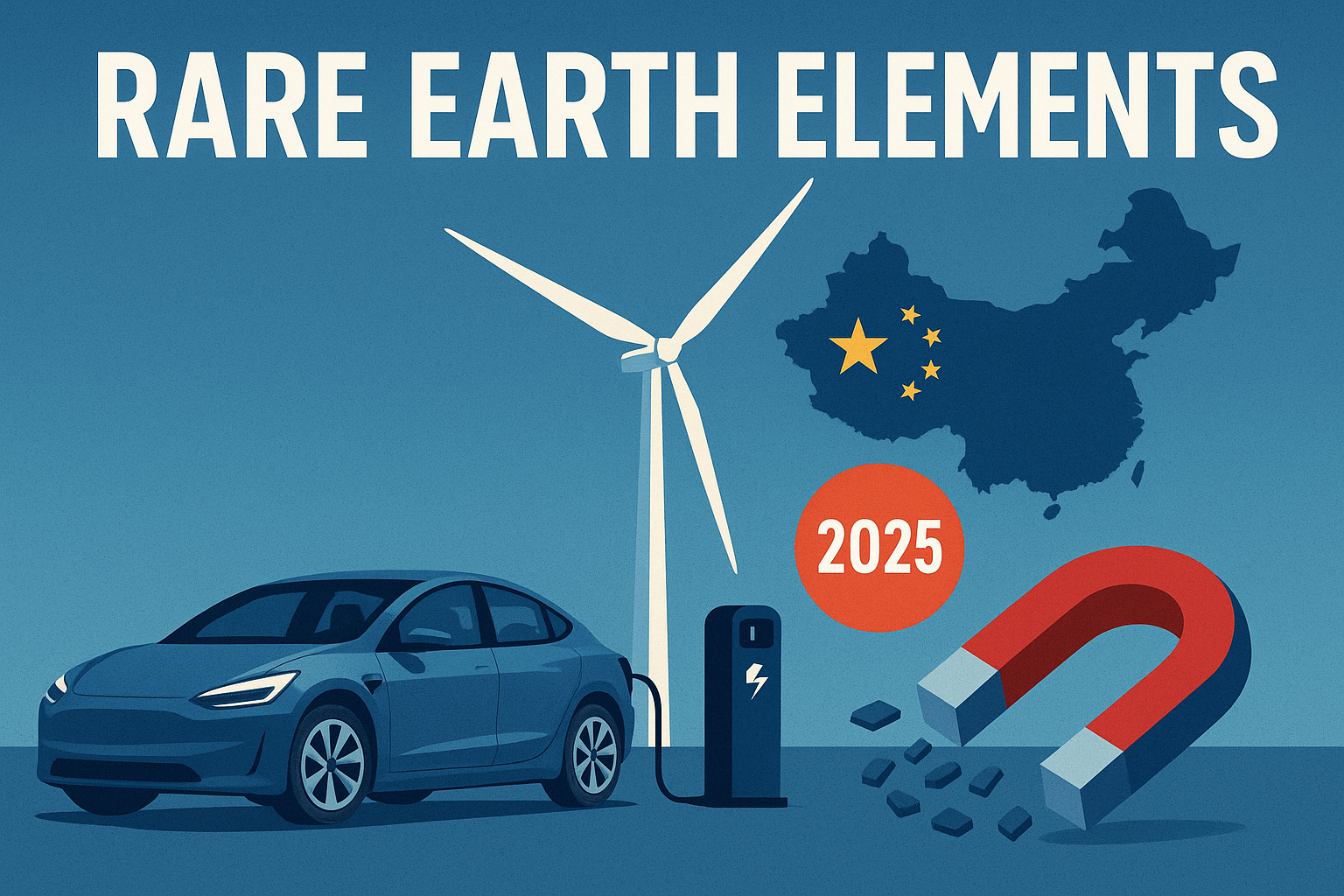What are Rare Earth Elements (REEs)?
Rare earth elements (REEs) are a group of 17 chemically similar elements: the 15 lanthanides, plus scandium and yttrium.
- Light REEs: lanthanum, cerium, praseodymium, neodymium, samarium
- Heavy REEs: europium, gadolinium, terbium, dysprosium, holmium, erbium, thulium, ytterbium, lutetium, plus yttrium
Despite their name, REEs are not actually rare. Many are as abundant as copper in the Earth’s crust. What makes them “rare” is the challenge of finding concentrated, mineable deposits and the complex, costly, and environmentally challenging refining process required to separate them.
Think of them as the vitamins of the modern economy: small in quantity but absolutely essential.
Why Rare Earths Matter
Rare earths give unique magnetic, optical, and catalytic properties. In small doses, they unlock technologies we rely on every day:
- Permanent Magnets (NdFeB): Neodymium and praseodymium (NdPr), often with dysprosium (Dy) and terbium (Tb), create the world’s strongest magnets.
- Catalysts & Polishing: Cerium and lanthanum are essential in oil refining, catalytic converters, and glass polishing.
- Phosphors & Optics: Europium, terbium, and yttrium are used in displays, lasers, and Fiber optics.
- Defence & Aerospace: Guidance systems, radar, drones, actuators, and advanced alloys all depend on REEs.
A modern electric vehicle (EV) may use 2–3 kg of rare earth magnets, while a single wind turbine can contain hundreds of kilograms of REEs in its generator.
In short, REEs are the quiet enablers of electrification, clean energy, and advanced Défence technology.
Industries Dependent on Rare Earths
- Electric Vehicles (EVs) – Most EV motors use NdFeB magnets for efficiency and longer driving range.
- Renewable Energy – Direct-drive wind turbines rely heavily on REE magnets.
- Consumer Electronics – Smartphones, laptops, headphones, hard drives, and cameras.
- Industrial Automation – Robotics, CNC machines, precision motors.
- Defence & Aerospace – Missiles, radar, drones, jet engines, satellites.
- Energy & Chemicals – Oil refining, hydrogen fuel cells, and emissions control.
Without REEs, many of these industries would slow down or require bulky, less efficient alternatives.
The Geopolitics of Rare Earths
Rare earths are not just a scientific curiosity—they’re a strategic resource.
China’s Dominance
- ~70% of global REE mining and ~85–90% of processing happens in China.
- China also controls the midstream (separation, metals, and magnet production).
- Export controls on dysprosium, terbium, and magnet-making technology give China a powerful geopolitical lever.
The US Response
- The US is reviving domestic REE supply through MP Materials (Mountain Pass, California) and Defence Production Act incentives.
- The challenge: refining and magnet-making are still developing outside China.
Europe’s Push
- The EU Critical Raw Materials Act (2023) mandates that by 2030:
- 10% of consumption comes from EU mining,
- 40% is processed in the EU,
- 25% comes from recycling.
The Indo-Pacific & Allies
- Australia’s Lynas remains the largest non-China REE producer, with expansions into the US and potential heavy-REE projects.
- Japan, South Korea, and India are investing in joint ventures and supply diversification.
Myanmar Factor
- A major supplier of heavy REEs (like dysprosium and terbium).
- Political instability and military crackdowns have repeatedly disrupted supply—adding volatility to global markets.
Why the Spotlight in 2025?
The world is paying unprecedented attention to REEs because:
- Electrification boom: EVs, wind power, robotics, and data centres keep demand rising.
- Geopolitical risks: China’s export licensing, Myanmar’s instability, and company-level shifts (like MP Materials adjusting supply) have spiked NdPr prices in 2025.
- Policy shifts: The US and EU are pouring billions into REE refining, magnet plants, and recycling to reduce dependency.
- Defence concerns: With global security tensions, supply chain resilience for REEs is a top defence priority.
The Heart of the Matter: NdFeB Magnets
Neodymium-Iron-Boron (NdFeB) magnets are the workhorses of the REE world.
- They are 10x stronger than traditional ferrite magnets.
- Found in everything from Tesla motors to offshore wind turbines.
- Dysprosium and terbium are critical for high-temperature stability, making them vital for EVs and defence tech.
Research is ongoing to:
- Reduce Dy/Tb use through grain-boundary diffusion,
- Recycle magnets from e-waste and old wind turbines,
- Develop alternatives (manganese-based magnets, ferrites with new designs).
But for now, NdFeB remains king.
Risks and the Road Ahead
- Single-point dependency: China’s dominance is a supply-chain risk.
- Environmental challenges: Mining and refining are messy; cleaner tech is needed.
- Market volatility: Prices of NdPr, Dy, Tb can swing dramatically on news of supply shifts.
- Recycling limits: End-of-life EVs and turbines are only now beginning to provide scrap feedstock.
Still, momentum is clear: global supply diversification is underway, and governments see REEs as central to both economic and national security.
Final Word
Rare earth elements are the hidden backbone of the modern economy. In 2025, they sit at the intersection of energy transition, industrial policy, and geopolitics.
- They power EVs, wind turbines, smartphones, and defence tech.
- They are dominated by China, but global players are racing to build alternative supply chains.
- They are volatile but indispensable.
In short: the future of clean energy, digital innovation, and national security depends on rare earths—and the world has finally woken up to that fact.

Leave a Reply